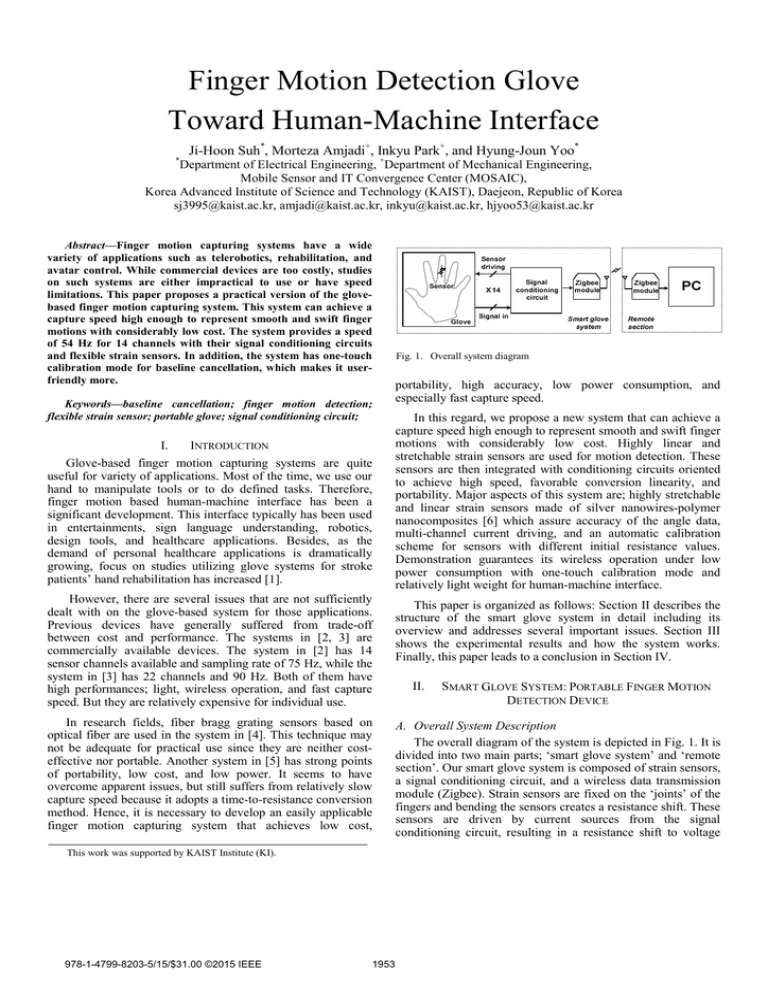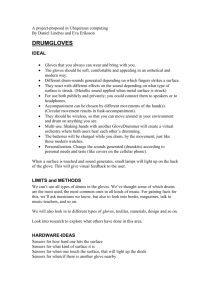Finger Motion Detection Glove Toward Human-Machine Interface Ji-Hoon Suh , Morteza Amjadi
advertisement

Finger Motion Detection Glove Toward Human-Machine Interface * Ji-Hoon Suh*, Morteza Amjadi+, Inkyu Park+, and Hyung-Joun Yoo* Department of Electrical Engineering, +Department of Mechanical Engineering, Mobile Sensor and IT Convergence Center (MOSAIC), Korea Advanced Institute of Science and Technology (KAIST), Daejeon, Republic of Korea sj3995@kaist.ac.kr, amjadi@kaist.ac.kr, inkyu@kaist.ac.kr, hjyoo53@kaist.ac.kr Abstract—Finger motion capturing systems have a wide variety of applications such as telerobotics, rehabilitation, and avatar control. While commercial devices are too costly, studies on such systems are either impractical to use or have speed limitations. This paper proposes a practical version of the glovebased finger motion capturing system. This system can achieve a capture speed high enough to represent smooth and swift finger motions with considerably low cost. The system provides a speed of 54 Hz for 14 channels with their signal conditioning circuits and flexible strain sensors. In addition, the system has one-touch calibration mode for baseline cancellation, which makes it userfriendly more. Keywords—baseline cancellation; finger motion detection; flexible strain sensor; portable glove; signal conditioning circuit; I. INTRODUCTION Glove-based finger motion capturing systems are quite useful for variety of applications. Most of the time, we use our hand to manipulate tools or to do defined tasks. Therefore, finger motion based human-machine interface has been a significant development. This interface typically has been used in entertainments, sign language understanding, robotics, design tools, and healthcare applications. Besides, as the demand of personal healthcare applications is dramatically growing, focus on studies utilizing glove systems for stroke patients’ hand rehabilitation has increased [1]. However, there are several issues that are not sufficiently dealt with on the glove-based system for those applications. Previous devices have generally suffered from trade-off between cost and performance. The systems in [2, 3] are commercially available devices. The system in [2] has 14 sensor channels available and sampling rate of 75 Hz, while the system in [3] has 22 channels and 90 Hz. Both of them have high performances; light, wireless operation, and fast capture speed. But they are relatively expensive for individual use. In research fields, fiber bragg grating sensors based on optical fiber are used in the system in [4]. This technique may not be adequate for practical use since they are neither costeffective nor portable. Another system in [5] has strong points of portability, low cost, and low power. It seems to have overcome apparent issues, but still suffers from relatively slow capture speed because it adopts a time-to-resistance conversion method. Hence, it is necessary to develop an easily applicable finger motion capturing system that achieves low cost, This work was supported by KAIST Institute (KI). 978-1-4799-8203-5/15/$31.00 ©2015 IEEE 1953 Fig. 1. Overall system diagram portability, high accuracy, low power consumption, and especially fast capture speed. In this regard, we propose a new system that can achieve a capture speed high enough to represent smooth and swift finger motions with considerably low cost. Highly linear and stretchable strain sensors are used for motion detection. These sensors are then integrated with conditioning circuits oriented to achieve high speed, favorable conversion linearity, and portability. Major aspects of this system are; highly stretchable and linear strain sensors made of silver nanowires-polymer nanocomposites [6] which assure accuracy of the angle data, multi-channel current driving, and an automatic calibration scheme for sensors with different initial resistance values. Demonstration guarantees its wireless operation under low power consumption with one-touch calibration mode and relatively light weight for human-machine interface. This paper is organized as follows: Section II describes the structure of the smart glove system in detail including its overview and addresses several important issues. Section III shows the experimental results and how the system works. Finally, this paper leads to a conclusion in Section IV. II. SMART GLOVE SYSTEM: PORTABLE FINGER MOTION DETECTION DEVICE A. Overall System Description The overall diagram of the system is depicted in Fig. 1. It is divided into two main parts; ‘smart glove system’ and ‘remote section’. Our smart glove system is composed of strain sensors, a signal conditioning circuit, and a wireless data transmission module (Zigbee). Strain sensors are fixed on the ‘joints’ of the fingers and bending the sensors creates a resistance shift. These sensors are driven by current sources from the signal conditioning circuit, resulting in a resistance shift to voltage Fig. 3. a) Varience of sensor resistance and b) signal conditioning concept Fig. 2. Signal conditioning circuit signal. The maximum number of available channels is 14 and the output voltage signals from the sensors are properly conditioned (amplification and baseline cancellation) on analog domain and then converted into digital data. This information is conveyed to the first Zigbee module and the data is transmitted wirelessly to the remote section. In the remote part, another Zigbee module linked to a computer, receives the transmitted data which is then visualized for virtual hand control. B. Structure and Operation of Signal Conditioning Circuit The structure of the signal conditioning circuit is described in Fig. 2. In order to drive the sensors and record the resistance value corresponding to the finger bending position, current sources are employed. We used the current source method for resistance to voltage conversion due to its high conversion linearity and speed. Even though there are other popular methods such as Wheatstone bridge or resistance-to-time conversion, they have considerable limitations for fast and accurate motion capturing applications since they suffer from inherent conversion nonlinearity and time-dependency on resistance shift. Taking this into account, we used current sources to enhance the accuracy of finger motion data considerably since the resistance is linearly proportional to the voltage under a constant current. The measured voltage signals of the sensors then should be properly conditioned to make them safely swing within the dynamic range of analog-to-digital converter (ADC). Due to the finite resolution of the ADC, sensor signals should be amplified as large as possible in order to enhance the conversion accuracy. In addition, the dynamic characteristics of our silver nanowires-polymer nanocomposite strain sensors such as initial resistances and sensitivities are all different from each other. This is largely because of the laboratory experiment limitations. As shown in Fig. 3a, two strain sensors fabricated by the same process may bear different electromechanical properties. This difference severely limits amplifier gain and signal swing range [7] if any additional signal conditioning process is not adopted. Hence, the presented conditioning circuit must overcome this issue by employing an adaptive baseline voltage setting scheme. The construction of baseline voltage setting scheme is as follows. The conditioning circuit in Fig. 2 consists of two 1954 stages: a preamplifier (OA1) and a baseline canceller (OA2). The preamplifier, a noninverting amplifier, first amplifies the incoming sensor signals. And the second stage, a form of difference amplifier, acts as a baseline canceller. Fig. 3b presents the conditioning concept of these two stages. After preamplification, the baseline is adaptively subtracted for each sensor signal. To operate this properly, baseline voltages need to be figured out at first and a corresponding reference voltage must be generated. The cancellation scheme goes through the following process: • Once the external calibration switch is pressed, the microprocessor reads every baseline voltage of the sensor signals throughout all 14 channels, by switching the multiplexer. • The microprocessor figures out the baseline voltage of each channel and calculates the reference voltage for cancellation, and stores that value. • By referring to the stored value, the microprocessor drives an external digital-to-analog converter (DAC) and cancels the baseline for each channel. C. Implementation on Printed Circuit Board The conditioning circuit is implemented using several commercial devices which are mounted on a printed circuit board (PCB) shown in Fig. 4. Current sources for driving the sensors are designed using PMOSs (ALD1107); 16-to-1 multiplexer (ADG706) is used for switching the 14 channels; Fig. 4. The front and back of designed PCB Unused channels CH5 Reserved for wireless data transmission CH2 Reserved for wireless data transmission CH3,4 CH1 CH 1-5 Unused channels 1.26 ms 18.52 ms (54 Hz) 18.52 ms (54 Hz) a) b) Fig. 7. a) Sensor signals and b) baseline cancellation result Fig. 5. a) Smart glove and b) completely mounted PCB and opamps (OPA4376) compose amplifier and baseline cancellation stages. DAC which generates the reference voltage for the baseline canceller is MAX5101. Microcontroller (ATmega16A) including a 10-bit ADC performs the data conversion and overall system control like channel switching, DAC control, and memorizing the baseline values. This PCB is also mounted with a quite popular Micro USB receptacle and charge control IC (MCP73833) for convenient recharge of a battery. Also, a 3.3-V voltage regulator (TLV70033) globally provides power for all devices. Our smart glove and its completely mounted PCB are shown in Fig. 5. During the usage, the Zigbee module (XBee1) and 3.7-V/570 mAh rechargeable lithium-polymer battery (H503038) are plugged into their own receptacles. The Zigbee module has a carrier frequency of 2.4 GHz and works at 115.2 kbps of baud rate in this work. The overall size of PCB is 4.5 x 4.5 cm2 which is small enough to be fixed on the back of the glove. Under a 3.3-V global voltage supply, this system totally consumes 65 mA, mainly by the Zigbee module which consumes 50 mA alone. The system consistently works for 8.5 hours with fully charged battery. D. Strain Sensors We have developed highly stretchable and sensitive strain sensors based on silver nanowires-polymer nanocomposites, as reported on [6, 8]. Our strain sensors could be stretched to more than 70% with good sensitivity. The resistance of the strain sensors increases upon stretching due to the disconnection of silver nanowires. The more stretching, the more disconnection of silver nanowires happens, increasing the electrical resistance linearly. Photograph of the strain sensors is Fig. 6. a) Photograph of a strain sensor made of the silver nanowirepolymer nanocomposite, b) a strain sensor at the initial length and 100% of stretching, and c) relative change of the resistance vesus bending angle shown in Fig. 6a. The strain sensors possess good flexibility and stretchability and can be attached to the human body. Fig. 6b illustrates a strain sensor at initial length and with more than 100% of stretching, showing the high stretchability of these strain sensors. When the strain sensors are attached in the finger joints, a bending strain is applied to the sensors, causing a resistance shift on them. Fig. 6c depicts the response of the strain sensor during the bending of the finger. As shown in the figure, relative change of the strain sensor is linearly increased by increasing the bending angle. Therefore, information of the bending angle could be calculated from the resistance change of the strain sensors. III. EXPERIMENTAL RESULTS A. Sensor Signals and Baseline Cancellation Fig. 7 shows the sensor signals and resulted baseline cancellation. In Fig. 7a, the time of 1.26 ms is allotted to each channel, and a total time period of 18.52 ms, including wireless data transmission, is necessary for the 14 channels to read the sensor signals once. In other words, it represents a finger motion capture speed of 54 Hz for 14 channels. In this measurement, we used 5 sensors to see the sensor signals and left the remaining channels disconnected. As shown in Fig. 7a, the sensors possess different initial resistance values. Our aim on baseline cancellation is to set all different baseline voltages of sensor signals to ground since this process Fig. 8. Demonstration set of the smart glove system 1955 TABLE I. • The calibration switch is pressed and each baseline voltage is set to ground, getting the glove ready for operation. SYSTEM SUMMARY Parameter Value Unit Operation voltage 3.3 V Caputre speed 54 Hz PCB size 4.5 x 4.5 cm2 Power consumption 214.5 mW Working time 8.5 hours Zigbee carrier frequency 2.4 GHz Communication speed (Baud rate) 115.2 kbps Available number of channels 14 ea. IV. will provide the largest gain and widest swing range. Fig. 7b shows the baseline cancellation result where every baseline voltage falls to the ground except for the disconnected channels. Once the finger joint is bent, the voltage starts to increase from ground proportionally to the bent angle. For the unused channels, from channel 6 to 14, they stay slightly upper than ground, which informs the user that the channels are ready to connect. REFERENCES [1] B. Demonstration of the Smart Glove with Virtual Hand Fig. 8 shows the demonstration set of finger motion capturing using our smart glove. An additional Zigbee module is plugged into the USB port of a personal computer, which receives the data transmitted from smart glove. The received data is then visualized by Labview virtual hand. Capturing speed of 54 Hz obviously shows smooth and swift movement of the avatar. [5] The operation of overall system follows a simple procedure described below. [6] • The PCB on the smart glove is turned on. At this time, transmitted data is not meaningful because each baseline is not set properly yet. [7] • Stretch out all the fingers in order to get every strain sensor under no strain conditions, which also indicates the lowest resistance and baseline voltage. [8] 1956 CONCLUSION A practical version of a finger motion detection glove is proposed in this paper. Highly stretchable and linear strain sensors are mounted on the finger joints for motion detection. Strain sensors are integrated with signal conditioning schemes such as the current driving method and the adaptive baseline cancellation, providing accurate and fast capturing speed. Our smart glove is inexpensive, portable, wireless, light, simple to use and has long working time. The performance of the smart glove system is summarized in Table I. For better user convenience, automatic gain control can be adopted for each sensor to remove the effect of sensitivity difference between sensors. Studies on adaptive gain control and other issues are under process, and we expect this device to become convenient to use for human-machine interface based on finger motion detection. [2] [3] [4] L. Dipietro, A. M. Sabatini, and P. Dario, “A survey of glove-based systems and their applications,” IEEE Trans. Syst., Man Cybern. Part C, Appl. Rev., vol. 4, no. 4, pp. 461-482, 2008. 5DT Data Glove Ultra: http://www.5dt.com CyberGlove II Wireless Glove: http://www.cyberglovesystems.com A. F. da Silva, A. F. Goncalves, P. M. Mendes, and J. H. Correia, “FBG sensing glove for monitoring hand posture,” IEEE Sens. J., vol. 11, no. 10, pp. 2442–2448, 2011. M. Borghetti, E. Sardini, and M. Serpelloni, “Sensorized glove for measuring hand finger flexion for rehabilitation purposes,” IEEE Trans. Inst. Meas., vol. 62, no.12, pp. 3308-3314, 2013. M. Amjadi, A. Pichitpajongkit, S. Lee, S. Ryu, I. Park, “Highly stretchable and sensitive strain sensors based on silver nanowireelastomer nanocomposite,” ACS Nano, vol. 8, no. 5, pp. 5154-5163, 2014. D. J. Rairigh, G. A. Warnell, C. Xu, E. T. Zellers, and A. J. Mason, “CMOS Baseline tracking and cancellation instrumentation for nanoparticle-coated chemiresistors,” IEEE Trans. Biomed. Circuits Syst., vol. 3, no. 5, pp. 267---276, 2009. M. Amjadi, A. Pichitpajongkit, S. Ryu, and I. Park, “Piezoresistivity of AG NWS-PDMS nanocomposite,” Micro Electro Mechanical Systems (MEMS), 2014 IEEE 27th Int. Conf., 2014, pp. 785-788.







